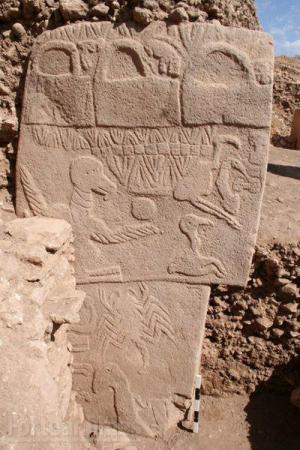|
A photograph of this stone is shown in Figure 1 and the relevant comparative stars are highlighted in red. The spatial distances are not entirely accurate, which could relate to some extent to the change in relative star positions over the last 10,000 years, but is more due to an artistic or stylized representation of them.
Figure 1.
Vulture and Scorpion stone compared to modern Star Map
(Gobekli Tepe photo used with permission, copyright DAI)
The first interesting form is the scorpion, which might first be thought to represent is known as Scorpius, but this does not appear to be the case. This is due to the presence of the three birds to the middle right (A, B, C), these three most clearly correspond to the “Summer Triangle” stars, the three birds, one represented by each star: Cygnus, Aquila (aka Vultur volans), and Vultur cadens (Lyra). The shape of the Aquila constellations holds the same general appearance as bird A, the angle of the Cygnus stars matches the shape of the body of bird B, with the feet angling off in the same direction as the neck of theCygnus constellation. Bird C corresponds to the star Vega and perhaps some other stars taken together.
Thus the bird D with wings rising upwards matches the shape of the constellation Pegasus taking some Andromeda stars to form the upward wings and another star of Pegasus defining the legs angled off to the right. The head is drawn together from a bunch of lesser stars. Notice that the two stars within the head correspond to the two eyes in the drawing.
Running underneath these two major forms is a division line, which might crudely represent either the Ecliptic or the Celestial Equator, or might simply appear in coincidence. Beneath this dividing line is the scorpion E, which corresponds to no specific constellation, but some of the stars from Aquarius and a few others. The bird head F beneath the scorpion also corresponds to a “hook” of stars represented mostly by Piscis Austrinus. To the left of the scorpion is another hook that combines some stars from Aquarius along with the loop of stars from Pisces. Some of the stars in the lower loop of Aquarius and Sculptorappear to represent the partial head and limbs of a boar H.
The bones I above all the figures is a backbone and thus would most clearly be a representation and concept of the Milky Way, but the actual course of the path of the Milky Way more closely follows the zigzag pattern M that runs above and beneath the actual bones of the backbone, which itself might indicate the “backbone of night” idea was metaphorical (although at one time might have been the Milky Way itself). The animal J is most probably a squirrel, which would be representing the approximate position and orientation of Cassiopeia. (The Cassiopeia constellation was known among the Norse as the squirrel Ratatosk, but they don’t appear to be related.) The other two small figures located on either side of J within the backbone spaces represent other star formations: the bent figure on the left L is the constellation Perseus, the upside-down figure to the right N would be the constellation Hercules.
The object that poses the greatest difficulty is the circle K located right above the vulture D’s left wing. It does not clearly correspond to any fixed star on a current star map, and might represent another object such as the full Moon or a supernova. A supernova is possible, given the concentration of stars along the Milky Way would clearly increase the odds of a bright star at that location. Further investigation would be required to locate the remains of such a supernova at that location.
Regardless of the mysterious identification of object K, there is abosolutely no doubt that these figures represent constellations, and an attempt to specify the stars comprising the constellations are shown in Figure 2. |

